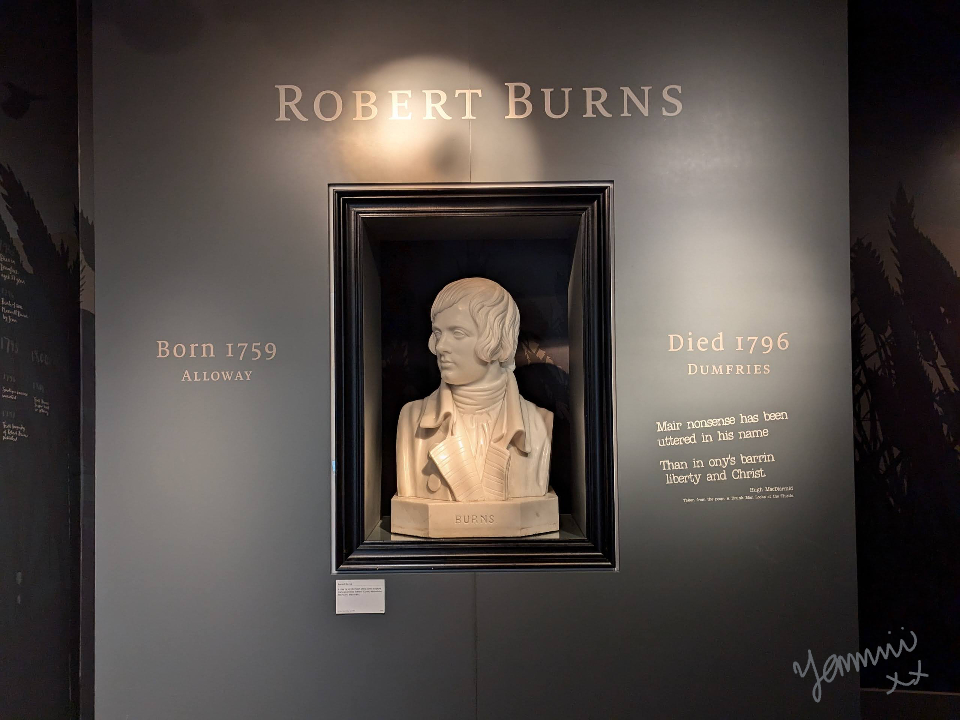This is part one of two brought to you from the large museum space and environment based in Alloway (now a suburb of Ayr), which celebrates the life and works of Scotland's most famous bard. You can read the basic life story on this link.
Why the term bard rather than a poet? Well, he was an amazing poet, but he was also an active reciter of his works and a storyteller and raconteur. It was, in part, his ability to perform in this way that he rose through society and became so beloved that his birthday continues to be celebrated every year on the 25th of January.
Burns clubs and societies are everywhere, not just in Scotland but in many other countries where the Scottish diaspora settled, notably in the USA, where the fervour is almost greater than that of Rabbie's homeland. As I mentioned last week, a significant contribution of funds comes to the National Trust from the collected clubs in the States to support the work and property in Alloway. It also became apparent that quite a few staff had roots over the pond. I had the opportunity to spend a little time chatting with one young lass in particular. She had been prompted to come to Scotland in search of family history (and, as so many are, under the influence of the telly show Outlander [that's the sound of my teeth clenching, sorry]). She met a young fellow, which resulted in a wedding, and she is now working in a place she clearly adores. She was also very keen on my crochet shawl, as she is learning to crochet now - and she could recite several of Burn's works by heart, putting me well to shame!!!
My father was good with memory recitals, too. It's a skill, no doubt about it! The modern museum building houses the expected gift shop (quality stuff at the National Trust—very little tatt), cafeteria, education room, and main exhibit space. This vast, high, barn-like space is very tastefully set out. Rather than going in an obvious sequential, chronological flow, it has grouped all related works according to subject matter. Matters of the heart, politics, social commentary... that sort of thing. There is lots of space to linger with each cabinet and absorb the Scots tongue. There are listening devices so the viewer can hear the spoken word. (It is important to understand that Scots is an independent language and is as valid for national identity as the Gaelic. In the northeast, there is also the Scots dialect of Doric, which has many words that differ from Scots.)
There are many examples of Burn's writing; the notebooks are clearly well-handled by the writer, blotted and annotated in places. He had a fine script. There is, of course, a treasured first edition of the first volume of poetry printed in Kilmarnock. Six hundred and twelve copies were produced. It sold out, and another imprint was needed. This was produced in Edinburgh, 3250 copies. That, too, sold like hotcakes..., and so it went on! Beside the cabinet containing one of the original 612 is possibly my favourite part of the museum... a digitised edition of the entire first book of poems which plays delightfully with a few of the poems, including one of my favourites, "The Twa Dogs".
I spent quite a while at this spot! I will happily return and read more. Many of Burns' works stimulate artistic imagination, not least the two dogs. There is a bronze seat along the Poets Walk on the grounds and an oak-wood chair created from the original Kilmarnock printing press. Then there are the various scenes from Tam 'o Shanter.












Looks like an interesting place.
ReplyDeletethe twa dogs really exist... we guessed it!!!!
ReplyDeleteThanks for this, YAM. Interesting history. Burns certainly left his mark on the world.
ReplyDeleteThe Burns museum looks interesting, the exhibits look great. Nice to see you posing with the statue, the dog statues are cute. Take care, have a great day!
ReplyDeletetruly a beautiful museum and all of the art work is gorgeous. the info on Burns I knew none of it. not even that he wrote the song. in fact the only thing I knew before now is the name of the song. all of this is news to me. even the part about the USA being a big part. I live under a rock ha ha
ReplyDeleteInterestingly informative.
ReplyDeleteWhat a great place to visit and spend lot of time exploring. How nice that there is as much to see outside as in.
ReplyDeleteWhat a wonderful post today! Loved reading about Bard Rabbie! It's funny, I have always preferred the storytelling musical "bard" type artists(Al Stewart comes to mind, along with Bruce Springsteen).
ReplyDeleteWhat a fabulous museum!
ReplyDeleteHi Yam - so much change has happened in recent years ... better facilities, museum directors better at setting out their stories for us to understand. Interesting and I can imagine you'd be beguiled into happily spending time there - and I'm sure you'll be there again soon. We used to have Burns Night in South Africa - mighty hot on occasions - haggis didn't help ... cheers Hilary
ReplyDelete"Let that aye be your border," Burns. You have broken down the borders of my interest in Burns.
ReplyDelete